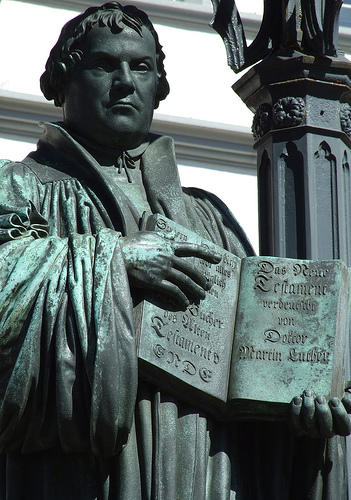 In 1519 Martin Luther wrote a short “Meditation on the Passion of Christ” for Holy Week. His Good Friday sermon begins with three wrong ways by which to meditate on Christ’s passion. Some do it to vent their anger at the Jews or at Judas. Others do it superstitiously or blindly, carrying pictures, booklets, letters or even crosses on their person as a kind of talisman to ward off evil and misfortune. “Christ’s suffering is thus used to effect in them a lack of suffering contrary to his being and nature” (Luther, “A Meditation on Christ’s Passion” in Lull (ed.), Martin Luther’s Basic Theological Writings, 165). Others feel pity for Christ, lamenting and bewailing his innocence.
In 1519 Martin Luther wrote a short “Meditation on the Passion of Christ” for Holy Week. His Good Friday sermon begins with three wrong ways by which to meditate on Christ’s passion. Some do it to vent their anger at the Jews or at Judas. Others do it superstitiously or blindly, carrying pictures, booklets, letters or even crosses on their person as a kind of talisman to ward off evil and misfortune. “Christ’s suffering is thus used to effect in them a lack of suffering contrary to his being and nature” (Luther, “A Meditation on Christ’s Passion” in Lull (ed.), Martin Luther’s Basic Theological Writings, 165). Others feel pity for Christ, lamenting and bewailing his innocence.
The correct way to meditate on the passion is to see his wounds as our sins, and so let our conscience be terrified and weighed down by the reality of human sin and divine wrath.
They contemplate Christ’s passion aright who view it with a terror-stricken heart and a despairing conscience. This terror must be felt as you witness the stern wrath and the unchanging earnestness with which God looks upon sin and sinners, so much so that he was unwilling to release sinners even for his only and dearest Son without his payment of the severest penalty for them. … You must get this thought through your head and not doubt that you are the one who is torturing Christ thus, for your sins have surely wrought this (166-167).
We must give ourselves wholly to this matter, for the main benefit of Christ’s passion is that man sees into his own true self and that he be terrified and crushed by this. Unless we seek that knowledge, we do not derive much benefit from Christ’s passion. The real and true work of Christ’s passion is to make man conformable to Christ, so that man’s conscience is tormented by his sins in like measure as Christ was pitiably tormented in body and soul by our sins. This does not call for many words but for profound reflection and a great awe of sins (108).
But there is more. Having been fully awakened to our own sin, we must now also turn fully to Christ:
After man has thus become aware of his sin and is terrified in his heart, he must watch that sin does not remain in his conscience, for this would lead to sheer despair. Just as [our knowledge of] sin flowed from Christ and was acknowledged by us, so we must pour this sin back on him and free our conscience of it. … You cast your sins from yourself and onto Christ when you firmly believe that his wounds and suffering are your sins, to be borne and paid for by him. [Luther cites Isaiah 53:6, 1 Peter 2:24, and 2 Corinthians 5:21] … You must stake everything on these and similar verses. The more your conscience torments you, the more tenaciously must you cling to them. If you do not do that, but presume to still your conscience with your contrition and penance, you will never obtain peace of mind, but will have to despair in the end (170).
We see in the resurrection of Christ his triumph over the wounds and sins by which he suffered. We see also his love, and that of the Father, in his bearing of sins on our behalf. True meditation on the passion of Christ must progress from Good Friday to Easter Sunday.
If we allow sin to remain in our conscience and try to deal with it there, or if we look at sin in our heart, it will be much too strong for us and will live on forever. But if we behold it resting on Christ and [see it] overcome by his resurrection, then boldly believe this, even it is dead and nullified. Sin cannot remain on Christ, since it is swallowed up by his resurrection. Now you see no wounds, no pain in him, and no sign of sin. Thus Paul declares that “Christ died for our sin and rose for our justification” (Romans 4:25). That is to say, in his suffering Christ makes our sin known and thus destroys it, but through his resurrection he justifies us and delivers us from all sin, if we believe this (170-171).
The third and final movement in fruitful meditation on Christ’s passion then follows:
After your heart has thus become firm in Christ, and love, not fear of pain, has made you a foe of sin, then Christ’s passion must from that day on become a pattern for your entire life. Henceforth you will have to see his passion differently. Until now we regarded it as a sacrament which is active in us while we are passive, but now we find that we too must be active, namely, in the following… (171)
Luther goes on to discuss the nature of a cruciform life, using the image of Christ’s suffering to resist temptation and the despair or sloth that may issue from adversity.
*****
Follow this link for a copy of the sermon and a historical introduction.
(Continued tomorrow)